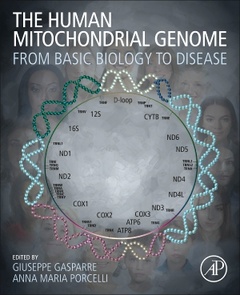Description
The Human Mitochondrial Genome
From Basic Biology to Disease
Coordinators: Gasparre Giuseppe, Porcelli Anna Maria
Language: English
Subjects for The Human Mitochondrial Genome:
Keywords
?5-methylcytosine; 5mC; AAV; Aging; Animal models; Annotation; Artifacts; Base excision repair; Bioinformatics; Bisulfite sequencing; Cancer; Cancer evolution; Cancer markers; Cell models; Clinical manifestations; Clonal expansion; Clonality; DNA methyltransferase; DNMT; DNTPs; Databases; Deletions; Depletion; Diagnosis; Dialysis; Disease; Encephalopathy; Enzyme replacement; Evolution; Forensic genetics; Forensic identification; Gene editing; Gene therapy; Genome editing; Germline genetic bottleneck; Haplogroups; Heteroplasmy; Homoplasmy; Human mtDNA variability; Intercellular mitochondrial transfer; Intra- and interspecies variability; Lentivirus; Liver failure; Mass spectrometry; McrBC; Mendelian mitochondrial disease; Methylation; MitoTALEN; Mitochondria; Mitochondrial DNA; Mitochondrial DNA deletions; Mitochondrial DNA heteroplasmy; Mitochondrial DNA phylogeny; Mitochondrial DNA point mutation; Mitochondrial DNA repair; Mitochondrial DNA segregation; Mitochondrial DNA selection; Mitochondrial RNA granule; Mitochondrial damage; Mitochondrial disease; Mitochondrial diseases; Mitochondrial double-strand break repair; Mitochondrial gene expression; Mitochondrial genetics; Mitochondrial genome; Mitochondrial homologous recombination; Mitochondrial transcription; Mitochondrial translation; Mitochondrial transplantation; Mitogenome; Mitoribosome; MtDNA; MtDNA copy number; MtDNA deletions; MtDNA depletion; MtDNA heteroplasmy; MtDNA inheritance; MtDNA maintenance; MtDNA mutations; MtDNA rearrangements; MtDNA replication; MtDNA segregation; MtDNA sequencing; MtDNA single variants; MtSSB; Myopathy; Next generation sequencing; Nucleoid; Nucleoids; Nucleosides; Nucleotide excision repair; NumtS and genome assembly; NumtS compilations; NumtS contamination; NumtS detection; NumtS discovery; NumtS insertion mechanisms; OXPHOS; Oncocytoma; Oncojanus
596 p. · 19x23.3 cm · Paperback
Description
/li>Contents
/li>Readership
/li>Biography
/li>Comment
/li>
The Human Mitochondrial Genome: From Basic Biology to Disease offers a comprehensive, up-to-date examination of human mitochondrial genomics, connecting basic research to translational medicine across a range of disease types. Here, international experts discuss the essential biology of human mitochondrial DNA (mtDNA), including its maintenance, repair, segregation, and heredity. Furthermore, mtDNA evolution and exploitation, mutations, methods, and models for functional studies of mtDNA are dealt with. Disease discussion is accompanied by approaches for treatment strategies, with disease areas discussed including cancer, neurodegenerative, age-related, mtDNA depletion, deletion, and point mutation diseases. Nucleosides supplementation, mitoTALENs, and mitoZNF nucleases are among the therapeutic approaches examined in-depth.
With increasing funding for mtDNA studies, many clinicians and clinician scientists are turning their attention to mtDNA disease association. This book provides the tools and background knowledge required to perform new, impactful research in this exciting space, from distinguishing a haplogroup-defining variant or disease-related mutation to exploring emerging therapeutic pathways.
Part 1 – Biology of human mtDNA 1. MtDNA replication, maintenance and nucleoid organization 2. Human mitochondrial transcription and translation 3. Epigenetic features of mitochondrial DNA 4. Heredity and Segregation of mtDNA
Part 2 - MtDNA evolution and exploitation 5. Haplogroups and the history of human evolution through mtDNA 6. Human Nuclear mitochondrial Sequences (NumtS) 7. MtDNA exploitation in forensics
Part 3 – MtDNA mutations 8. Human mitochondrial DNA repair 9. Mechanisms of onset and accumulation of mtDNA mutations 10. Mitochondrial DNA mutations and ageing 11. Methods for the identification of mitochondrial DNA variants 12. Bioinformatics resources, databases, and tools for human mtDNA 13. Methods and models for functional studies on mtDNA mutations
Part 4 – MtDNA-determined diseases 14. Mitochondrial DNA point mutation diseases 15. Nuclear genetic disorders of mitochondrial DNA gene expression 16. mtDNA maintenance: disease and therapy 17. MtDNA mutations in cancer 18. MitoTALENs for mtDNA editing 19. Mitochondrially-Targeted Zinc Finger Nucleases 20. Mitochondrial movement between mammalian cells: an emerging physiological phenomenon
Anna Maria Porcelli is Associate Professor of Biochemistry at the University of Bologna. She conducts her research in the field of cellular biochemistry with particular interest for the role of mitochondria and mitochondrial DNA in the metabolic and hypoxic adaptation during the different stages of tumor progression using cybrid and in vivo models. In particular, she analyzed the functional impact of mtDNA mutations in gene encoded for complex I subunits by using a challenging approach such as the allotopic expression. She is the scientific coordinator of an ITN Marie Curie consortium, funded by the European Community. The main goal of this consortium is to educate and train young students in the cancer metabolism field, with a particular focus on mitochondria in tumor progression.
- Fully examines recent advances and technological innovations in the field, enabling new mtDNA studies, variant and mutation identification, pathogenic assessment, and therapies
- Disease discussion accompanied by diagnostic and therapeutic strategies currently implemented clinically
- Outlines and discusses essential research protocols and perspectives for young scientists to pick up
- Features an international team of authoritative contributors from basic biologists to clinician-scientists
These books may interest you

Mitochondrial DNA and Diseases 158.24 €

Mitochondrial DNA and Diseases 158.24 €


